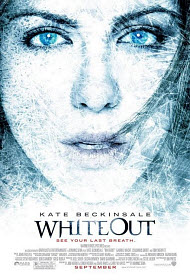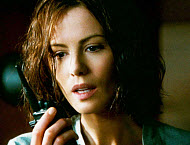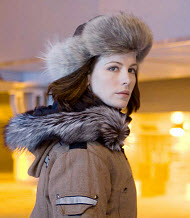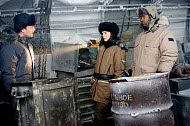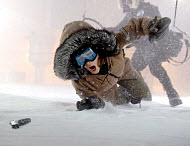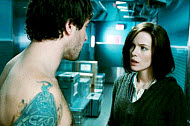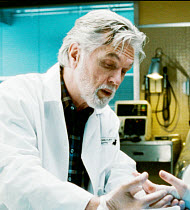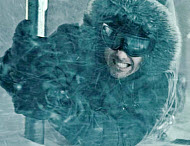Whiteout
 for violence, grisly images, brief strong language and some nudity.
for violence, grisly images, brief strong language and some nudity.
Reviewed by: Michael Karounos
CONTRIBUTOR
| Moral Rating: | Better than Average |
| Moviemaking Quality: |
|
| Primary Audience: | Adults Teens |
| Genre: | Crime Action Thriller |
| Length: | 1 hr. 36 min. |
| Year of Release: | 2009 |
| USA Release: |
September 11, 2009 (wide—2,700+ theaters) DVD: January 19, 2010 |
| Featuring |
|---|
|
Kate Beckinsale — “The Aviator,” “Underworld,” “Pearl Harbor” Gabriel Macht, Tom Skerritt, Columbus Short, Alex O'Loughlin, Shawn Doyle, Joel Keller, Jesse Todd, Arthur Holden, Erin Hickock, Bashar Rahal, Julian Cain, Dennis Keiffer, Andrei Runtso, Roman Varshavsky, Steve Lucescu, Paula Jean Hixson, Craig Pinckes, Sean Tucker, Marc James Beauchamp, Nick Villarin, Louis Dionne, Patrick Sabongui |
| Director |
|
Dominic Sena |
| Producer |
| Warner Bros. Pictures, Dark Castle Entertainment, Don Carmody, Susan Downey, Christoph Fisser, David Gambino, Steve Richards, Greg Rucka, Joel Silver, Charlie Woebcken |
| Distributor |
“See your last breath.”
“Whiteout,” is based on Greg Rucka’s 1999 Eisner Award-winning comic book miniseries of the same name.
“Whiteout” stars Kate Beckinsale as a U.S. Marshall investigating a series of murders in Antarctica. Beckinsale’s character (Carrie Stetko) has psychological baggage and a past which requires certain scenes to be shown four or five times in flashback in order to lengthen the film and pound the point home to the viewer. Unfortunately, there is no point. “Whiteout” is a mystery without suspense.
Alfred Hitchcock famously defined a “macguffin” as the object which occupies the audience’s interest while the filmmaker gets to romp in the cinematic playground of his mind. In “Whiteout,” the audience doesn’t learn what the macguffin is until the last few minutes of the film. Moreover, it doesn’t matter. Learning what it is that the characters kill one another for doesn’t improve the story because director Dominick Senna and writers Jon and Erich Hoeber are unable to create any interest in the identity of an object which is anonymous until the end. By that point, it’s too late, and it may as well be jelly beans for as much as it explains why it caused otherwise dedicated professionals to become murderers. The motive simply is not convincing. It would have been far more interesting to watch a character undergo a change due to the pressure of an irresistible temptation than it is to suddenly spring a weak plot twist onto the viewer at the end.
As far as the extreme cold goes, the film may as well be shot in Minnesota. The temperature is impressive at —55 Celsius, but at -67 Fahrenheit it is not that much colder than the -80 wind chill that I endured several times in Chicago. The film half-heartedly tries but doesn’t illustrate the effects of that kind of cold very well. One character talks about the cold (which is boring), and once coffee spills and freezes almost immediately (more interesting). Mainly, the film relies on a howling sound track and people acting cold, which simply doesn’t do justice to those conditions.
Cinematically, setting a film in Antarctica is unusual and should create interesting scenarios that Senna doesn’t take advantage of. The CGI storms are not utilized well, and a “whiteout” is inherently boring. There is not much difference between having a chase scene in whiteout conditions and having a chase scene in complete darkness. There is an art to making danger immediate, and that art is not in evidence here.
What’s frightening about Antarctica is its barenness. The one scene staged on the open tundra takes place inside, which is a mistake. Senna demonstrates no understanding of the landscape as a psychological location in the same way that John Ford used Monument Valley in his many Westerns. Nor does Senna explore the effect of living in that desolation. The characters talk about being there for “six months,” but never once do the writers put a speech in the mouth of a character exploring the edge of madness. They just shrug and move on. They don’t care; the audience doesn’t care.
The audience’s credibility is challenged by the film’s faulty physics. In one scene, a plane crash shows the plane bouncing on the ice, people and cargo being thrown around, and bottles of vodka remaining unbroken. In another scene, the wind is powerful enough to sweep people away one second and has no effect in the next. As cold as it is, there is at least one scene when Beckinsale’s character stands in a blast of frigid air and shows no response. But then there’s too much “reality” when the film relies on the cheap gross-out effects of “CSI corpse chic.”
I have read the graphic novel, and the movie’s fault is that it follows it too closely without translating its premise into film. A movie is not a comic book, and the film has to show character development. In “Whiteout,” none of the characters change for better or for worse. Their faulty nature is hidden and then revealed, but this is not the same thing as showing the psychological change from good to evil.
The film tries to tell a moral about trust, but it fails there as well. Stetko lost her trust in close relationships before arriving at the station, as remote in person as the station is in place. Unfortunately, the film begins and ends with her communicating aloofness, not intimacy. The reviews are the worst I can remember for a movie, a mere 3% approval at Rotten Tomatoes, which I suspect reflects the critics disgust with its hodge-podge plot and zero character development. “Whiteout” is not particularly violent or offensive or exciting. I am grateful that it didn’t target Christians, the military, conservatives, or business people, but the best one one can say of it is that it’s just a washout.
Violence: Moderate / Profanity: Minor / Sex/Nudity: Minor
See list of Relevant Issues—questions-and-answers.


PLEASE share your observations and insights to be posted here.
